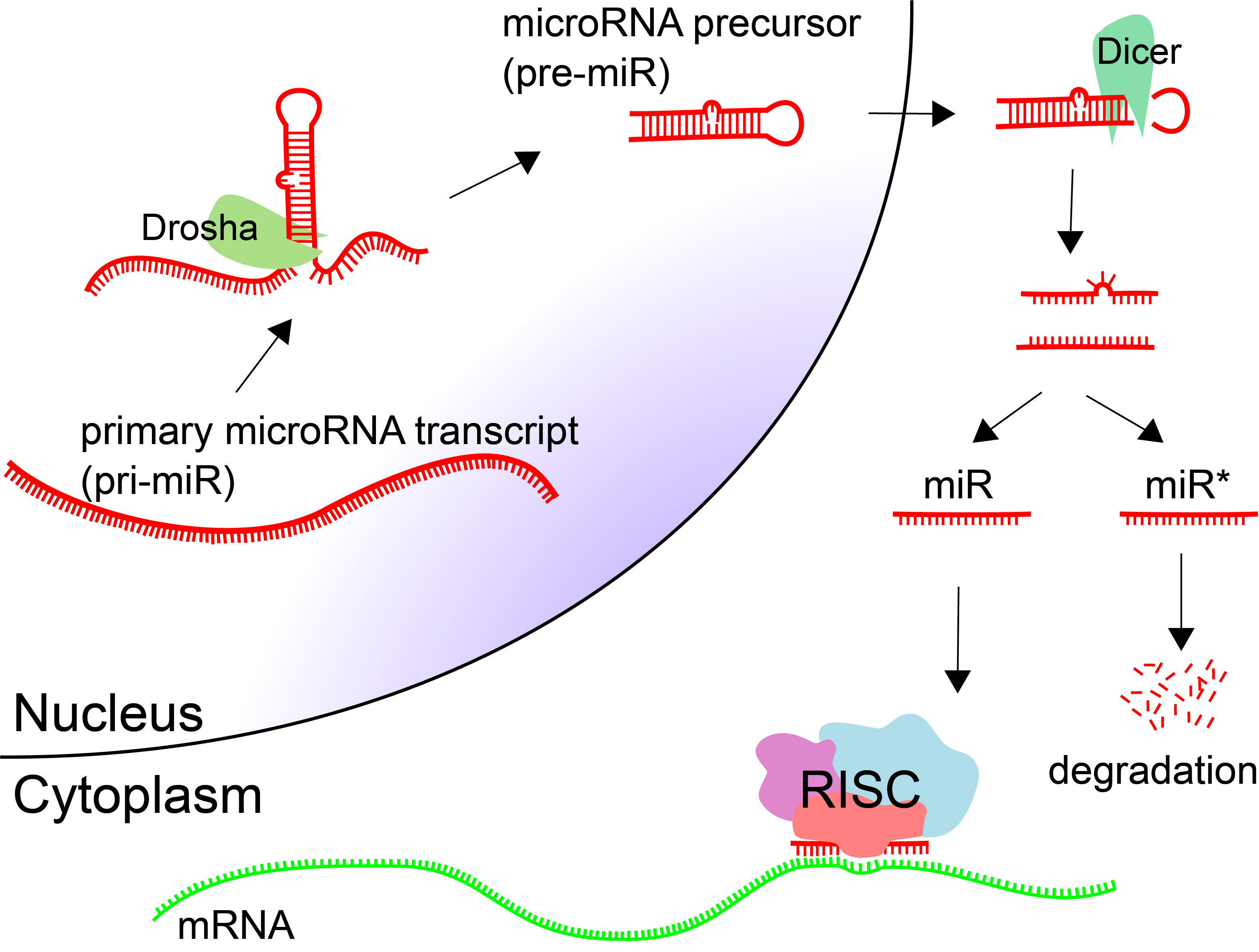MicroRNA has become a pivotal area of study in the field of gene regulation, following revolutionary insights from Nobel laureate Gary Ruvkun. His groundbreaking work in the early 1990s revealed the critical roles these small non-coding RNAs play in regulating gene expression, particularly in the widely studied model organism, C. elegans. As scientific funding surged for RNA research, the significance of microRNA extended beyond initial skepticism, capturing the attention of researchers exploring its potential to influence human health. This raised urgent questions about its applications in therapies for diseases such as cancer and Alzheimer’s, which are currently being evaluated in clinical trials. Ruvkun’s journey, marked by years of perseverance and dedication, culminated in a Nobel Prize that not only recognized his contributions but also emphasized the need for continued investment in scientific research and innovation.
MicroRNA, often referred to as small RNA molecules, are essential players in the regulatory systems of living organisms. This class of regulatory RNA has gained traction since the groundbreaking discoveries made by scientists like Gary Ruvkun, who have illuminated their importance in gene control mechanisms. With the expanding landscape of RNA biology, various facets of therapeutic development focusing on microRNA are emerging, showcasing their potential in treating complex diseases. Additionally, the growth of this research domain is often linked to increasing scientific funding, which has fostered a vibrant community of RNA researchers dedicated to understanding the intricacies of gene expression regulation. Collectively, these advancements underscore the pivotal role of microRNA in modern genetics, linking it to crucial health outcomes and the broader implications for medical science.
The Discovery of microRNA: A Paradigm Shift in Gene Regulation
In 1992, Gary Ruvkun and his collaborator Victor Ambros made a groundbreaking discovery that would redefine our understanding of gene regulation: the identification of microRNA. Initially published in the prestigious journal Cell in 1993, their research on the C. elegans roundworm challenged the prevailing notions within evolutionary biology. Although the immediate excitement was lukewarm, Ruvkun and Ambros’s efforts laid the groundwork for a myriad of developments within the RNA research community. This newfound understanding revealed how microRNA plays a pivotal role in controlling gene expression, a mechanism critical not only in worms but also across various species, including humans.
As time progressed, the significance of microRNA became undeniable, gaining traction within the scientific community. Researchers from diverse fields recognized the potential implications of these tiny RNA molecules in their studies, leading to an increase in collaboration and research funding. Moreover, the growing body of evidence highlighting the role of microRNA in various biological processes demonstrated its importance in health and disease. Understanding that these molecules manage protein-coding genes has been essential for advancements in therapeutic approaches for diseases such as cancer, heart disease, and neurodegenerative disorders.
The Role of NIH Funding in Advancing RNA Research
The journey of Gary Ruvkun highlights the critical importance of scientific funding, particularly from the National Institutes of Health (NIH), in fostering groundbreaking research. Ruvkun has benefitted from about $150,000 annually in federal funding over the past 40 years, which has supported his team and enabled significant discoveries in the field of RNA biology. He remarks on how this funding has allowed him to maintain a focused research environment, crucial for exploring the complexities of microRNA and gene regulation. Such support has been a linchpin, helping translate fundamental scientific inquiry into practical therapies that have the potential to revolutionize medicine.
Federal research grants not only provide direct support but also inspire confidence among younger scientists entering the field. Ruvkun expresses concern over recent calls to cut such funding, suggesting that a reduction could deter the next generation from pursuing careers in scientific research. The historical investment in scientific work has not only enhanced our understanding of molecular biology but has also catalyzed advancements in biotechnology, leading to companies specializing in RNA therapeutics. This connection exemplifies the vital role that public investment plays in maintaining a robust scientific community and driving innovation.
Translational Impact of microRNA Research on Medicine
The real-world impact of microRNA research has been profound, especially in the development of new therapeutic strategies. As scientists continue to explore the functions of microRNA, a burgeoning field has emerged, focused on harnessing these molecules for clinical use. Ongoing clinical trials aim to leverage microRNAs in treating a range of diseases, including prevalent conditions like heart disease and cancer. These advancements signify a remarkable shift where foundational research can directly influence therapeutic outcomes, illustrating the critical link between basic science and its application in medicine.
This translational aspect not only enhances patient care but also inspires further research initiatives within the RNA community. As interest grows, a collaborative spirit has emerged, uniting researchers from various disciplines to tackle complex diseases through RNA-based innovations. Given the success stories stemming from microRNA research, it is clear that continued exploration holds the promise of discovering new treatment modalities, further solidifying the relevance of Ruvkun and Ambros’s initial findings and underscoring the importance of sustained scientific funding in driving these initiatives.
Challenges and Opportunities in RNA Research Funding
Despite the exciting potential of RNA research, challenges persist in securing adequate funding. Ruvkun’s experience reflects a broader concern among researchers who worry that an unstable funding landscape might compel talented scientists to seek opportunities elsewhere. The past decades of substantial federal investment have facilitated remarkable advancements, yet ongoing debates about the allocation of scientific funds raise alarm bells for many in the field. Maintaining consistent financial support is crucial to prevent the brain drain from the United States and to ensure that pioneering research can continue.
Amid these challenges, opportunities arise as the significance of RNA research gains recognition beyond academia. Biotech companies are increasingly looking to partner with research institutions to tap into this rich vein of discovery. This trend offers a dual benefit: science pushes the frontiers of knowledge while also drawing in investment from the private sector. Ultimately, collaborative efforts between federal agencies, academia, and industry will be essential in fostering an environment where RNA research, especially the study of microRNA, can thrive and continue to transform health outcomes.
The Impact of Ruvkun’s Work on Future Generations of Scientists
Gary Ruvkun’s contributions to the understanding of microRNA have not only transformed the field of gene regulation but have also inspired countless young scientists to pursue careers in molecular biology. As a prominent figure in genetics, Ruvkun serves as a role model, demonstrating that significant scientific breakthroughs can emerge from perseverance and dedication to research. His experiences and the challenges he faced in securing funding resonate with many aspiring researchers, providing a comprehensive view of the scientific landscape and the importance of curiosity-driven exploration.
Ruvkun’s journey epitomizes the potential for basic research to create lasting change and influence future generations. As educational programs increasingly emphasize the significance of research experience, mentees trained under his guidance are likely to carry forward his legacy. The foundational principles he championed, combined with a commitment to exploring the intricacies of RNA biology, will empower upcoming scientists to address the pressing biomedical challenges of their time, fostering a new wave of innovation in health and disease treatment.
MicroRNA and Its Role in Agricultural Biotechnology
Beyond human health, microRNA research is carving a niche within the realm of agricultural biotechnology. As scientists delve deeper into the functions of these tiny RNAs, their potential applications in crop improvement take center stage. Researchers are uncovering how microRNAs regulate important genes that contribute to plant growth, stress response, and yield. This burgeoning field not only highlights the fundamental role of microRNA in a variety of organisms but also showcases its versatility in enhancing food security as the global population continues to rise.
By applying insights gained from model organisms like C. elegans, agricultural scientists can develop innovative strategies for crop enhancement, making them more resilient to environmental pressures. These advancements can have a transformative effect on agriculture, contributing to sustainable practices and increased productivity. As funding for agricultural research aligns with the interests of both the scientific community and policymakers, microRNA is set to play a key role in ensuring food sustainability and addressing the challenges posed by climate change.
Ethics and Responsibility in Biomedical Research
As research fields like RNA biology rapidly advance, ethical considerations become increasingly pertinent, particularly in the context of gene regulation and potential therapeutic applications. The burgeoning capacities of microRNA technologies prompt important discussions about the responsibility scientists carry when harnessing these discoveries. Ruvkun emphasizes the need for a balanced approach, advocating for rigorous ethical standards in research that prioritize safety, transparency, and accessibility. Ensuring that findings benefit society without compromising public trust in science is paramount as the field continues to evolve.
Scientists are tasked not only with advancing knowledge but also with navigating the implications of their research. This encompasses careful consideration of how therapies based on microRNA might affect patients, ethical usage, and equitable access to innovations. Ruvkun notes that public engagement plays a vital role in fostering a culture of accountability within the scientific community. Adopting a forward-thinking ethical framework will allow researchers to responsibly explore the frontiers of gene regulation, reinforcing the positive impacts of microRNA discoveries on human health and welfare.
Future Directions in Gene Regulation and microRNA Research
Looking ahead, the field of gene regulation, particularly in relation to microRNA, is poised for exciting developments. As technology advances, tools for studying RNA interactions and gene expression will become increasingly sophisticated, potentially unveiling nuances previously hidden from view. Researchers are optimistic that elucidating the complexities of microRNA networks will yield insights into not only gene regulation but also evolutionary biology and development. This holistic understanding will help translate basic research findings into pertinent medical applications.
Moreover, an increased focus on interdisciplinary collaboration will likely foster innovative approaches to tackling challenges in human health and agriculture. The intersection of molecular biology, bioinformatics, and clinical research will empower scientists to devise strategic interventions leveraging microRNA for therapeutic purposes. Continued investment in scientific funding will be crucial as researchers seek to harness these advancements, ensuring that the exploration of gene regulation yields significant benefits across multiple disciplines.
Frequently Asked Questions
What is the significance of microRNA in gene regulation research?
MicroRNA plays a critical role in gene regulation by controlling how genes are expressed in various organisms, including humans. The foundational discovery of microRNA by Gary Ruvkun and Victor Ambros opened up new avenues in RNA research, showing that these tiny molecules can regulate the translation of over half of human protein-producing genes.
How did Gary Ruvkun contribute to the discovery of microRNA?
Gary Ruvkun, along with Victor Ambros, discovered microRNA while researching gene regulation in C. elegans. Their work was initially met with skepticism but eventually earned them the 2024 Nobel Prize, highlighting the revolutionary nature of their findings in RNA research and gene regulation.
What diseases are targeted by microRNA-based therapies?
MicroRNA-based therapies are currently in clinical trials for various diseases such as heart disease, cancer, Crohn’s Disease, and Alzheimer’s. These therapies leverage our understanding of microRNA’s role in gene regulation to develop innovative treatments.
What funding sources have supported microRNA research?
MicroRNA research has been predominantly funded by the National Institutes of Health (NIH) grants, which have allowed scientists like Gary Ruvkun to explore the intricacies of gene regulation and the potential applications of microRNAs in medicine.
How has the recognition of microRNA evolved since its discovery?
Since its discovery in 1992, microRNA has gained significant recognition in the scientific community. Initially regarded with skepticism, the understanding of its fundamental role in gene regulation has led to an explosion of interest in RNA research, attracting a diverse range of scientists.
What impact has microRNA research had on the pharmaceutical industry?
Research on microRNA has significantly impacted the pharmaceutical industry, leading to the establishment of companies like Alnylam, which focuses on RNA interference therapeutics. This has highlighted the importance of federal funding in advancing scientific discoveries that drive economic growth.
How do microRNAs influence human development and function?
MicroRNAs influence human development and function by regulating gene expression, which is vital for translating genes into proteins essential for various biological processes. Studies have identified approximately 1,000 microRNAs in the human genome, underscoring their importance.
What challenges face scientists studying microRNA today?
Scientists studying microRNA face challenges such as securing consistent funding for research. The pressure to cut federal funding for scientific endeavors poses a risk to ongoing research, which is crucial for making further advancements in understanding gene regulation.
What is the relationship between microRNA and scientific funding?
Scientific funding, especially from federal sources like the NIH, has been instrumental in enabling research on microRNA. This funding supports the exploration of gene regulation and the development of novel therapies, showcasing the vital link between financial support and scientific progress.
How might the future look for microRNA research and application?
The future of microRNA research looks promising, with continued interest in its potential therapeutic applications for various diseases. As the understanding of microRNA’s role in gene regulation deepens, it is likely that innovative treatments and technologies will emerge, further advancing the field.
| Key Points | Details |
|---|---|
| Discovery of microRNA | MicroRNA was discovered by Gary Ruvkun and Victor Ambros in 1992, which later earned them the 2024 Nobel Prize in physiology or medicine. |
| Initial Reception | Their findings were initially met with indifference by the evolutionary biology community, as the significance of their work for other species, including humans, was not immediately clear. |
| Role of Federal Funding | Much of Ruvkun’s research was funded by the NIH, highlighting the importance of government support in scientific advancements. |
| Clinical Applications | MicroRNA therapies are currently in clinical trials for several diseases, including heart disease, cancer, Crohn’s Disease, and Alzheimer’s. |
| Impact on Industry | Ruvkun’s research has contributed to the rise of significant biotechnology companies, such as Alnylam Pharmaceuticals. |
| Concerns about Funding Cuts | Ruvkun expresses concerns regarding potential cuts to federal research funding, fearing this could deter young scientists from pursuing careers in research. |
Summary
MicroRNA plays a crucial role in gene regulation and has been instrumental in advancing our understanding of biological processes. The research by Gary Ruvkun and Victor Ambros has not only opened new avenues for scientific inquiry but also paved the way for innovative therapies to treat various diseases. The continued support for microRNA research is vital for the development of effective treatments and to maintain the momentum in this rapidly evolving field.



